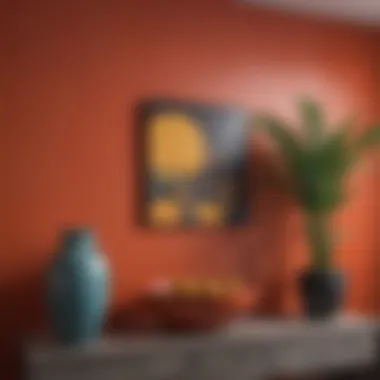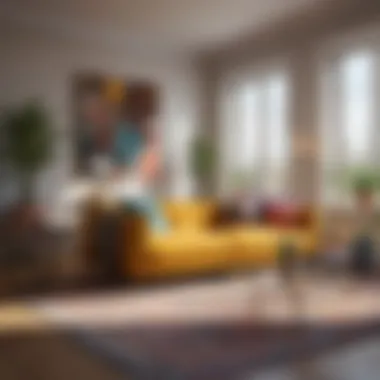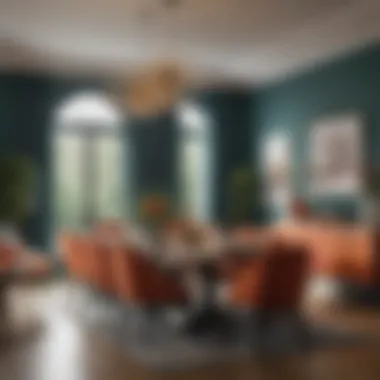Incorporating a Pop of Color in Interior Design


Intro
Incorporating a burst of color into interior design can transform bland spaces into vibrant, engaging environments. Color has profound psychological effects and influences human emotions and perceptions. Understanding how to effectively use color allows homeowners and design enthusiasts to create spaces that resonate with personal style while uplifting moods.
We will explore methods for selecting and integrating color accents. Comprehensive discussions on trendy color palettes and the impact of colors on surroundings will also be included. This narrative serves as a guide for applying color in ways that enhance aesthetics and evoke desired emotions.
Design Inspiration
Current Interior Design Trends
The modern interior design landscape is increasingly embracing bold colors. Gone are the days when neutral tones dominated. Designers are now advocating for striking hues that capture attention. Current trends highlight the importance of balancing vibrant colors with calming elements to create harmony within a space.
Consider the incorporation of colors like deep green, rich navy, and warm terracotta. These shades not only add depth but also connect interiors with nature, promoting tranquility. In addition, the concept of biophilic design is gaining traction; this is where nature-inspired colors are used to enhance indoor environments.
"Color interacts with design elements in intricate ways, influencing mood, space perception, and function."
Color Palettes and Their Effects
Choosing the right palette is critical in interior design. Different colors can evoke varying emotional responses:
- Blue: Generally perceived as calming. It can create a peaceful atmosphere.
- Yellow: Often associated with happiness and energy. It can invigorate a space.
- Red: A strong choice that may invoke excitement or passion. Use it sparingly to avoid overwhelming spaces.
- Green: Represents growth and relaxation. It promotes balance and can enhance well-being.
Curating a palette involves not just selecting colors but also recognizing how they will interact with furnishings and lighting. Designers recommend testing colors in different lights and against various textures.
Some approaches to palettes include:
- Monochromatic: Varying shades of a single color for a cohesive feel.
- Analogous: Colors next to each other on the color wheel; these combinations are harmonious.
- Complementary: Colors opposite each other on the color wheel, offering dynamic contrasts.
By understanding these effects, homeowners can make informed choices when introducing colors into their spaces. The right application of color can elevate the design and enrich the living experience.
Understanding Color Theory
Color theory plays a crucial role in interior design, providing a framework that allows designers to think critically about color choices. It involves understanding how colors interact, influence emotions, and impact space. This section discusses various aspects of color theory that serve as essential guidelines when incorporating a pop of color.
Basic Concepts of Color Theory
Color theory is based on the color wheel, a circular diagram illustrating the relationships between colors. Primary colors—red, blue, and yellow—are the foundation from which all other colors derive. Secondary colors come from mixing primary colors, while tertiary colors result from mixing primary and secondary.
Understanding color properties such as hue, saturation, and brightness is essential. Hue refers to the actual color, saturation describes its intensity, and brightness defines its lightness or darkness. Knowing these elements helps in selecting colors that achieve the desired atmosphere in a room.
Psychological Effects of Color
Colors evoke varying psychological responses. For instance, red may stimulate energy or passion, whereas blue often promotes calmness and tranquility. Understanding these effects is key for designers aiming to influence mood through color choices. It is beneficial to consider the purpose of the space when selecting colors. For example, a productive workspace might benefit from stimulating hues, while a bedroom should lean towards soothing tones.
Important color associations include:
- Red: Energy, passion
- Yellow: Happiness, optimism
- Green: Growth, balance
- Blue: Trust, calmness
- Purple: Creativity, luxury
By incorporating colors that reflect the intended use of a space, designers can enhance the emotional response of occupants.
Color Schemes and Their Impact
Color schemes are strategies that utilize color relationships effectively. A well-chosen color scheme can unify a design, while a poorly chosen one can create disarray. Common schemes include complementary, analogous, and monochromatic.
- Complementary Scheme:
- Analogous Scheme:
- Monochromatic Scheme:


- Uses colors opposite each other on the color wheel.
- Creates a vibrant look.
- Involves colors next to each other on the wheel.
- Produces harmony and comfort.
- Utilizes variations of a single color.
- Offers simplicity and elegance.
Knowing these systems allows homeowners and designers to make informed decisions about integrating bold colors into a design without overwhelming the space. The right combination of colors can turn a bland room into an inviting environment.
The Role of a Pop of Color
Definition and Importance
A pop of color refers to a bold, bright accent introduced into a more neutral context. This accent can be in various forms such as paint, décor items, textiles, or furniture. The importance of utilizing a pop of color lies in its ability to draw attention to specific areas of a room or to bring coherence to a design scheme. It can serve multiple functions:
- Focus: Directs the viewer’s eye to the featured area.
- Contrast: Provides a visual break amid muted tones, creating dynamic aesthetics.
- Energy: Infuses liveliness into otherwise dull spaces, stimulating energy and enthusiasm.
In essence, implementing this strategy is vital for designers and homeowners seeking to create a balanced yet exciting environment.
Cultural Associations with Color
Colors often carry varying meanings across different cultures. This must be taken into account when selecting tones for a space. Here are some insights into common cultural associations:
- Red: Represents passion, love, and energy in many cultures. Yet, in some places, it may also symbolize danger or anger.
- Blue: Often linked to tranquility and peace, it is a preference for calming spaces. In contrast, it may evoke sadness in certain contexts.
- Green: Usually symbolizes nature, growth, and harmony. The meaning can shift depending on its use in design, from a vibrant lime representing energy to a soft sage providing calm.
- Yellow: Typically conveys happiness and optimism. Its degree of brightness can similarly alter its emotional influence.
Understanding these associations can enhance the decision-making process when selecting a pop of color, ensuring the chosen hue aligns with both the desired atmosphere and cultural significance.
Choosing the Right Color
Choosing the right color is fundamental in the process of incorporating pops of color into interior spaces. A well-chosen color can transform a bland room into a vibrant and inviting environment. Understanding how color interacts with space, light, and personal style will significantly enhance the outcome of any design project.
Assessing the Space
Before making any color choices, it is vital to assess the space in question. Factors such as the size of the room, the amount of natural light, and the existing color palette play significant roles. Smaller spaces might benefit from lighter pops of color to avoid feeling cramped, while larger rooms can handle deeper hues as accents. The orientation of windows and the flow of light should also be considered. Rooms that receive abundant sunlight may amplify the intensity of colors, while dim or north-facing rooms might require warmer tones to create a cozy feeling. This assessment helps tailor color choices to suit the specific characteristics of each space, ensuring that the chosen colors enhance rather than detract from the overall aesthetic.
Incorporating Personal Style
Personal style is an essential consideration when selecting colors. Every homeowner has unique tastes and preferences that reflect their personality. It is beneficial to think about what makes one feel comfortable and inspired within their home. A bright and bold choice might appeal to someone with a dynamic lifestyle, whereas softer pastels may resonate more with those seeking tranquility. One way to incorporate personal style is to create a mood board. This board can include images, patterns, and colors that resonate with one's aesthetic. Ultimately, the chosen colors should reflect individuality and create a sense of belonging within the space.
Trending Colors in Design
Keeping an eye on trending colors can provide inspiration and inform choices that feel current and relevant. Color trends are often influenced by broader design movements, cultural shifts, and even the fashion world. In recent years, colors such as deep greens, warm terracottas, and muted pastels have gained popularity for their versatility and ability to create comforting atmospheres.
Consider including these trending colors in accents, such as cushions, artwork, or smaller pieces of furniture. For instance, a terracotta vase can add warmth to a room with neutral tones, while a deep green throw can introduce richness and depth. It’s important to note, however, that while trends are useful, one should choose colors that resonate personally. The right balance between current trends and personal preference will create a space that feels both stylish and uniquely yours.
Remember, choosing the right colors is not merely about aesthetics; it influences mood and energy in a space.
In summary, choosing the right color involves a careful consideration of various elements. Assessing the space, infusing personal style, and staying abreast of color trends will ensure that the application of color accents brings the intended vibrancy and warmth. The result will be a harmonious interior that speaks to the sensibilities of those who inhabit it.
Techniques for Introducing Color
Accent Walls
Accent walls are a fundamental technique in introducing a pop of color. This approach involves painting one wall a bold or contrasting hue compared to the other walls.
- Focus on Focal Point: An accent wall draws attention and can highlight a particular area such as a fireplace or a piece of furniture.
- Color Choices: Often, vibrant colors such as deep blue, rich red, or even bright citron can energize the room. It is wise to consider the existing decor to ensure harmony in the overall design.
- Simplicity in Execution: It's straightforward to apply, requiring only paint or wallpaper. This technique allows for flexibility; if you change your mind, it can be easily repainted.
Furniture and Textiles


Color can also be introduced through furniture and textiles. This method allows for dynamic integration of color without making permanent changes. Consider the following:
- Cushions and Throws: Adding colorful cushions or throws on a neutral sofa can quickly uplift the room's mood. Patterns can also bring additional visual interest.
- Accent Furniture: Bright chairs or a colorful coffee table can serve as conversation starters and create a more inviting atmosphere.
- Rugs: A vibrant area rug can be a fantastic base for introducing color, connecting different elements in the room and adding warmth.
Accessories and Decor
Accessories and decor items are excellent for incorporating pops of color within a space. They provide an easy way to experiment with color without a significant commitment. Here are some ideas:
- Vases and Picture Frames: Choose bold vases or colorful frames for artwork to showcase your style. They can be easily swapped out if preferences change.
- Lighting: Colored lamps or light fixtures can drastically change the ambiance of a room.
- Functional Decor: Items like colorful books, plants in vibrant pots or unique sculptures can serve aesthetic and functional purposes simultaneously.
Art and Wall Decor
Art and wall decorations are critical aspects of introducing color effectively. They add character and often become the centerpiece of attention. Consider the following:
- Large Art Pieces: A large canvas bursting with color can serve as a focal point.
- Gallery Walls: An assortment of art in varied colors creates a personalized touch. This also allows you to mix and match styles, textures, and colors effortlessly.
- Wall Murals: For the bold, a mural can envelop the room in color. This artistic expression can dramatically alter the viewer's experience in a space.
Remember that the key to successful color incorporation is balance. Too much color can overwhelm a space, while too little may leave it feeling flat. Each technique provides a unique opportunity to enhance your design.
These methods highlight the diversity and flexibility in introducing color to interior spaces. They allow for personalization, creativity, and evolution of the design, ensuring spaces resonate with their occupants.
Case Studies
Understanding how color influences interior design can greatly benefit from real-world examples. Case studies exemplify how different approaches create varied atmospheres, helping designers and homeowners alike visualize possibilities. They illuminate the choices made in specific situations and the effects those choices had on the overall space. This section seeks to highlight successful incorporations of color into both residential and commercial settings, detailing the thought processes behind these decisions.
Residential Spaces
In residential design, the objective is often to cultivate a home that reflects personal style while ensuring comfort. One notable case is a compact urban apartment that utilized vibrant blue accents against a neutral backdrop. The choice of blue was intentional, selected for its calming qualities, leading to a tranquil environment. The homeowner used blue throughout the space—from cushions to artwork—and created a cohesive flow.
- Accent Features: The blue had a dual function—serving both as an eye-catching focal point and as a connector between different areas of the apartment.
- Texture and Tone: Varied textures, such as plush rugs and sleek surfaces, complemented the color scheme, providing depth without overwhelming the senses.
Here, the pop of color did not merely exist; it became integral to the identity of the space.
Commercial Interiors
In commercial settings, color serves a different purpose. It can influence customer behavior and brand perception. A popular example is a coffee shop that chose to incorporate earthy greens and warm oranges in its design.
- Customer Engagement: The colors were selected based on psychological effects, where green promotes relaxation while orange stimulates social interaction. This combination encouraged customers to stay longer and engage with their surrounding environment.
- Brand Identity: The consistent use of color across branding materials like menus and signage reinforced the shop's identity. Patrons began to associate these colors with their experiences in the space, enhancing overall brand recognition.
These case studies illustrate the strategic application of color to achieve intended outcomes, whether in a private home or a public commercial space. Utilizing case studies not only provides insights into successful designs but also encourages aspiring designers to think critically about their color choices.
Common Mistakes to Avoid
Overuse of Color
One of the most significant missteps in interior design is the overuse of color. While a vibrant hue can create excitement and personality in a space, using too many colors can lead to a chaotic and overwhelming atmosphere. When a room is saturated with bold tones, it can confuse the eye and detract from other design elements.
To avoid this, focus on a few accent colors rather than a full spectrum. This strategy not only preserves the vibrancy of your chosen hues but also allows for better integration of other aesthetic components such as furniture and decor. It’s critical to balance colors, ensuring that they complement one another.
"Too much color can overwhelm a room, while too little can render it lifeless. Striking the right balance is essential."
Clashing Combinations
Another prevalent issue is the occurrence of clashing color combinations. Many individuals tend to choose colors based on personal preference rather than considering how these colors interact in a shared space. When certain shades oppose each other rather than aligning, the result can be jarring.
To create harmony, utilize a color wheel in selecting combinations. This tool shows which colors complement and contrast with one another. For instance, pairing complementary colors, such as blue and orange, can enhance a design, while adjacent colors like yellow and green create a more serene space. Taking the time to understand the relationships between colors will significantly aid in crafting a tranquil atmosphere and prevent color-induced discord.
Maintaining Balance with Color


Balancing color in interior design is crucial for achieving harmony within a space. When introducing a pop of color, one must consider the overall atmosphere and how colors interact with each other. A well-balanced color scheme enhances not only aesthetics but also the emotional response of anyone entering the room. This aspect can dictate whether a space feels chaotic or inviting.
Incorporating a singular vibrant hue should never overshadow the primary palette but rather complement it. Effective color management helps maintain visual focus and brings specific elements into sharper relief. Too much color can create distraction, whereas a balanced approach draws the eye naturally around the space, fostering a sense of comfort and ease.
The 60-30-10 Rule
The 60-30-10 rule serves as a guiding principle in balancing colors. This approach divides the color scheme into three distinct parts. Sixty percent is devoted to the dominant color, usually on walls or large furniture pieces. Thirty percent represents the secondary color, found in upholstery, window treatments, or other major accents. Finally, ten percent is reserved for the pop of color, typically introduced through smaller decor elements like cushions, art, or ornamental accessories.
This rule not only simplifies the selection process but also ensures that one color does not overpower another. Using this formula, colors can coexist, creating depth and layering within the design.
Creating Cohesion Through Color
Cohesion is vital in achieving a unified look in any design. When managing color, it is important to create visual connections across different elements of the space. This can be done through repetition and the strategic placement of colors. For instance, utilizing the same accent color in various areas pulls the design together, creating continuity.
Additionally, coordinating shades can enhance a room’s character. For example, if choosing a vibrant blue as a pop of color, consider using varying shades of blue in elements like vases, artwork, and throws. This not only creates a conversation but also supports the overarching design narrative.
A successful color scheme should feel intentional yet effortless. Balancing color does not mean all colors must match perfectly, but rather complement each other without creating visual clutter. Incorporating these principles will ensure that a pop of color serves its purpose effectively while maintaining a beautiful, coherent interior.
Sustainable Approaches to Color
In today's world, designing with a focus on sustainability is more vital than ever. Interior design is not just about aesthetics; it also involves considering the impact on the environment. Sustainable approaches to color are essential in this context. When we discuss incorporating a pop of color into a space, we should also consider how those colors affect our planet. Sustainable options not only enhance our living areas but also reduce our ecological footprint.
Choosing sustainable colors means selecting eco-friendly products that promote health and the environment. This focus on sustainability can manifest through various elements—like the type of paint one uses or the materials sourced for decor. It encourages a mindful approach, emphasizing quality over quantity in design selections. By prioritizing sustainability, homeowners and designers participate in a larger movement towards environmental responsibility.
Eco-Friendly Paint Options
When it comes to eco-friendly paint options, there are several brands that have stepped up to create less harmful and safer products. These paints often have low volatile organic compounds (VOCs), which can be liberating for indoor air quality. A few reputable options include Benjamin Moore's Regal Select and Behr's Premium Plus line. These brands provide vibrant hues while ensuring the health of a home isn't compromised.
Consumers can choose sustainable colors based on multiple factors:
- Natural Ingredients: Seek paints made from natural materials like clay, chalk, or plant-based oils.
- Certification: Look for certifications such as Greenguard or Green Seal. These signify the products have passed rigorous tests for low chemical emissions.
- Durability: Eco-friendly paints should not only be kind to the environment but also last longer, reducing the need for frequent repainting.
In addition to these traditional paint options, there are also innovative products such as mineral-based paints that are biodegradable and free from synthetic chemicals. They offer excellent coverage and are becoming increasingly popular among eco-conscious designers.
Sourcing Sustainable Decor
Decor plays a significant role in interior design, and sourcing sustainable decor is a crucial step in this process. Homeowners can opt for furnishings and accessories that not only provide aesthetic appeal but are also crafted with environmental consciousness in mind.
A few considerations for sourcing sustainable decor include:
- Recycled Materials: Look for items made from reclaimed wood, recycled metal, or other salvaged materials. These not only reduce waste but also often have unique character.
- Ethical Sourcing: Choose products from manufacturers who prioritize fair trade and ethical labor practices.
- Local Artisans: Supporting local craftspeople reduces carbon footprints associated with shipping and contributes to the local economy.
Here are some resources and platforms to consider:
- Etsy: A marketplace for handmade and vintage items that often features sustainable decor options.
- Thuma: Specializes in bed frames made from sustainably sourced wood.
- Made Trade: Offers a broad range of ethically made home goods.
"Sustainability in design reflects a commitment to a better future while enjoying the present."
Closure
In any discussion about interior design, the role of color cannot be overstated. In this article, we embarked on a journey through various aspects of incorporating a pop of color in interior spaces. Understanding the nuances of color theory is crucial. Not just the basics, but the psychological impacts specific hues can have on the atmosphere of a room.
Choosing the right color is a calculated decision. Assessment of the space, personal style, and current trends all guide this choice. Techniques for introducing color vary. These can include accent walls or incorporating dynamic textiles that catch the eye. Each method has its own unique advantages.
Moreover, we examined case studies showcasing successful implementations. Observing real-world applications helps to contextualize theoretical concepts. We also highlighted common mistakes to avoid while celebrating the artistic potential that color brings. Avoiding overuse and clashing combinations preserves the overall harmony in a design scheme.
A balanced approach is advised. Using principles such as the 60-30-10 rule establishes a foundation for cohesiveness. This balance ensures that the pop of color enhances rather than overwhelms. Additionally, sustainable practices were discussed, emphasizing eco-friendly options in paint and decor. Sustainability matters not just for the aesthetic but also for ethical considerations.
Ultimately, incorporating a pop of color is more than a design choice. It’s about evoking emotions and enhancing human experiences within a space. A thoughtful application can transform ordinary rooms into vibrant settings that reflect both personal style and broader aesthetic trends.
Color holds the power to uplift, energize, or even calm. Consideration of this ensures that each interior environment serves its purpose fully while also being visually engaging. When aware of how color impacts interaction with a space, the potential for creativity expands. This knowledge empowers homeowners, designers, and enthusiasts alike to appreciate the subtle yet profound influence of color.
"Color is the keyboard, the eyes are the harmonies, the senses are the symphony." - Wassily Kandinsky















